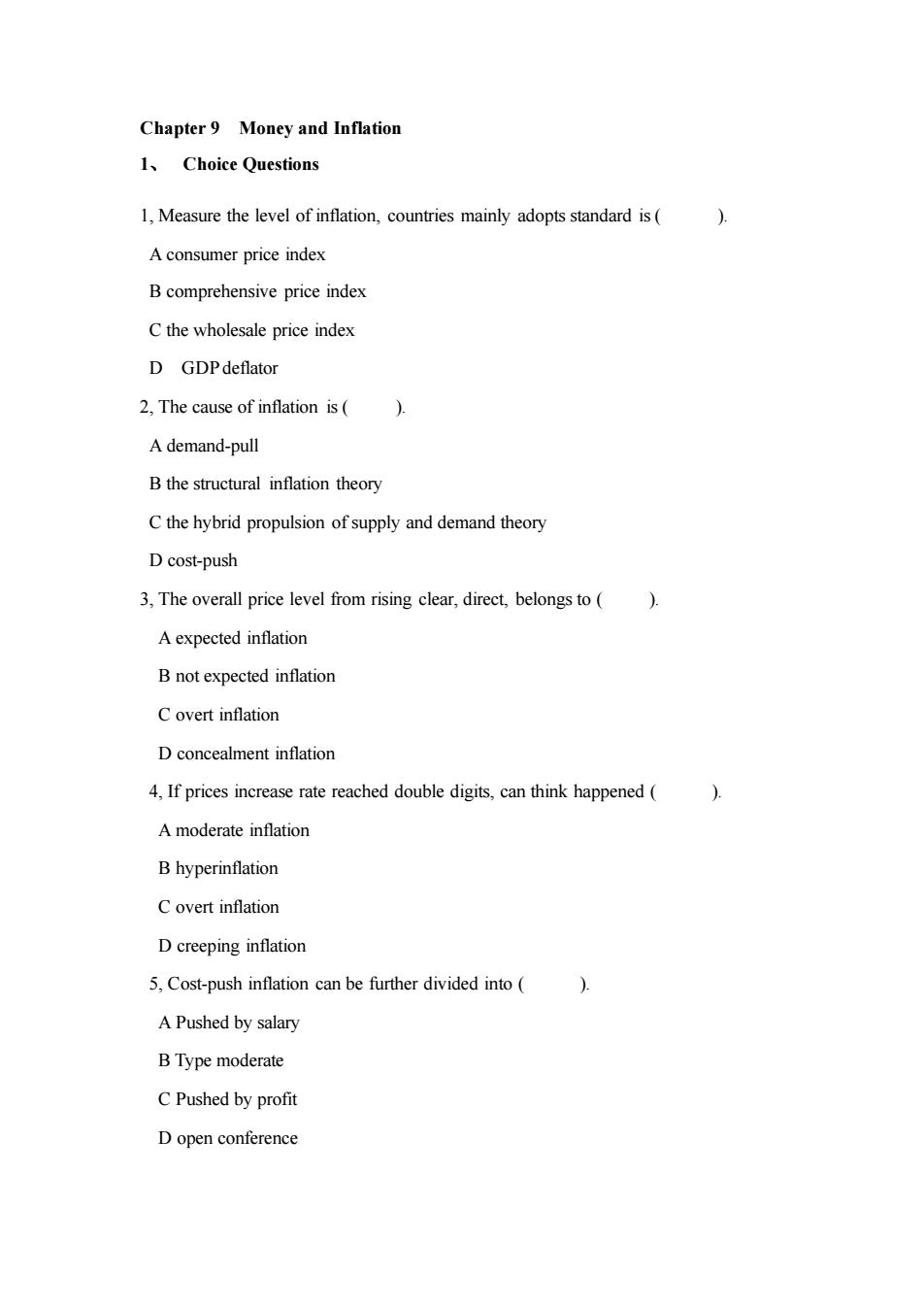
Chapter 9 Money and Inflation 1、Choice Questions 1,Measure the level of inflation,countries mainly adopts standard is( A consumer price index B comprehensive price index C the wholesale price index D GDP deflator 2,The cause of inflation is( A demand-pull B the structural inflation theory C the hybrid propulsion of supply and demand theory D cost-push 3.The overall price level from rising clear,direct,belongs to () A expected inflation B not expected inflation C overt inflation D concealment inflation 4,If prices increase rate reached double digits,can think happened A moderate inflation B hyperinflation C overt inflation D creeping inflation 5,Cost-push inflation can be further divided into A Pushed by salary B Type moderate C Pushed by profit D open conference
Chapter 9 Money and Inflation 1、 Choice Questions 1, Measure the level of inflation, countries mainly adopts standard is ( ). A consumer price index B comprehensive price index C the wholesale price index D GDP deflator 2, The cause of inflation is ( ). A demand-pull B the structural inflation theory C the hybrid propulsion of supply and demand theory D cost-push 3, The overall price level from rising clear, direct, belongs to ( ). A expected inflation B not expected inflation C overt inflation D concealment inflation 4, If prices increase rate reached double digits, can think happened ( ). A moderate inflation B hyperinflation C overt inflation D creeping inflation 5, Cost-push inflation can be further divided into ( ). A Pushed by salary B Type moderate C Pushed by profit D open conference

6,The neutral theory thinks that inflation )to output,and the economic growth. A positive effect outweigh the negative effects B neither positive nor negative effects C has both positive effect and negative effect D is effect is less than the negative effects 7,Structural inflation theorists think that there are four main factors to determine the trend of the development of a country's inflation.This is the four elements () A quantitative level B department of money wages rising at the same ratio C products of different department has different price elasticity of demand and income elasticity. D salary E.composed of two sectors of the economy have different labor productivity growth rates 8,Governance,the main inflation policies include A restrain aggregate demand policy B incomes policy C indexation policy D the adaptive policy 9,Raising interest rates policy belong to control inflation A expansion policy B positive policy C austerity D negative policy 10,Tightening monetary policy means the main A.improve the rediscount rate B reduce the rediscount rate C increase reserve rate
6, The neutral theory thinks that inflation ( ) to output, and the economic growth. A positive effect outweigh the negative effects B neither positive nor negative effects C has both positive effect and negative effect D is effect is less than the negative effects 7, Structural inflation theorists think that there are four main factors to determine the trend of the development of a country's inflation. This is the four elements ( ). A quantitative level B department of money wages rising at the same ratio C products of different department has different price elasticity of demand and income elasticity. D salary E. composed of two sectors of the economy have different labor productivity growth rates 8, Governance, the main inflation policies include ( ). A restrain aggregate demand policy B incomes policy C indexation policy D the adaptive policy 9, Raising interest rates policy belong to control inflation ( ). A expansion policy B positive policy C austerity D negative policy 10, Tightening monetary policy means the main ( ). A. improve the rediscount rate B reduce the rediscount rate C increase reserve rate

D reduce the reserve ratio 2.Short Answer Questions (1)Explain the demand-pull inflation using figures. (2)Analysis the causes of inflation in the view of supply of demand
D reduce the reserve ratio 2、Short Answer Questions (1)Explain the demand-pull inflation using figures. (2)Analysis the causes of inflation in the view of supply of demand